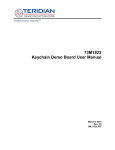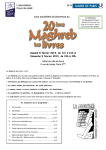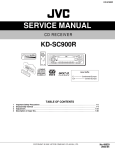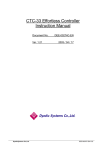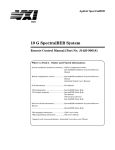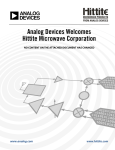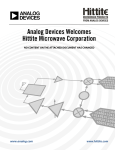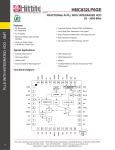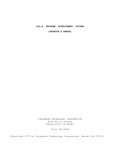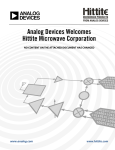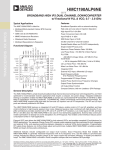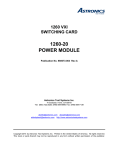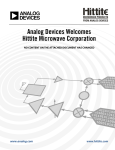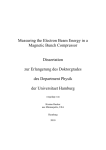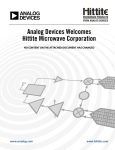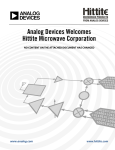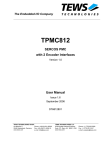Download HMC987lP5E - Analog Devices
Transcript
Analog Devices Welcomes Hittite Microwave Corporation NO CONTENT ON THE ATTACHED DOCUMENT HAS CHANGED www.analog.com www.hittite.com THIS PAGE INTENTIONALLY LEFT BLANK HMC987LP5E v03.1112 Clock Distribution - SMT LOW NOISE 1:9 FANOUT BUFFER DC - 8 GHz Typical Applications Features The is suitable for: Ultra Low Noise Floor: -166 dBc/Hz @ 2 GHz • SONET, Fibre Channel, GigE Clock Distribution • ADC/DAC Clock Distribution • Low Skew and Jitter Clock or Data Fanout • Wireless/Wired Communications • Level Translation • High Performance Instrumentation • Medical Imaging • Single-Ended to Differential Conversion Wideband: DC - 8 GHz Operating Frequency Flexible Input Interface: LVPECL, LVDS, CML, CMOS Compatible AC or DC Coupling On-Chip Termination 50 or 150 Ω (100/300 Ω Diff.) Multiple Output Drivers: Up to 8 Differential or 16 Single-Ended LVPECL Outputs: 800 mVpp into 50 Ω Single-Ended (+3 dBm Fo) One Adjustable Power CML/RF Output: -9 to 3 dBm Single-Ended Serial or Parallel Control, Hardware Chip-Enable Power-Down Current < 1 uA 32 Lead 5x5 mm SMT Package 25 mm2 Functional Diagram General Description The 1-to-9 fanout buffer is designed for low noise clock distribution. It is intended to generate relatively square wave outputs with rise/fall times < 100 ps. The low skew and jitter outputs of the HMC987LP5E, combined with its fast rise/fall times, leads to controllable low-noise switching of downstream circuits such as mixers, ADCs/DACs or SERDES devices. The noise floor is particularly important in these applications, when the clock-network bandwidth is wide enough to allow square-wave switching. Driven at 2 GHz, outputs of the HMC987LP5E have a noise floor of -166 dBc/Hz, corresponding to a jitter density of 0.6 asec/rtHz - or 50 fs over an 8 GHz bandwidth. The input stage can be driven single-ended or differentially, in a variety of signal formats (CML, LVDS, LVPECL or CMOS), AC or DC coupled. The input stage also features adjustable input impedance. It has 8 LVPECL outputs, and 1 CML output with adjustable swing/power-level in 3 dB steps. Individual output stages may be enabled or disabled for power-savings when not required using either hardware control pins, or under control of a serial-port interface. 1 For price, delivery and to place orders: Hittite Microwave Corporation, 2 Elizabeth Drive, Chelmsford, MA 01824 Phone: 978-250-3343 Fax: 978-250-3373 Order On-line at www.hittite.com Application Support: Phone: 978-250-3343 or [email protected] HMC987LP5E v03.1112 LOW NOISE 1:9 FANOUT BUFFER DC - 8 GHz Clock Distribution - SMT Table 1. Electrical Specifications Unless otherwise specified: T = 27 °C, Regulated VDD of 3.3 V, 2 GHz, 6 dBm in, AC coupled single ended input and output, 120 Ω/leg DC termination, AC coupled into 50 Ω measuring load. Effects of customer eval board (“Evaluation PCB Schematic”) are de-embedded. For convenience, all voltages are referenced to GND (0V), but negative supply references are acceptable. Parameter Conditions Min. Typ. Max. Units VDD (VCCHF=VCCA=VCCB=VCCRF) 3.0 3.3 3.6 V Input Common Mode Voltage 1.35 2 VDD - 0.2 V Input Swing (Single Ended) 0.2 2 Vpp DC Input Characteristics Input Capacitance 0.5 pF Input Impedance Single-Ended Selectable 50 / 150 Ω Differential Selectable 100 / 300 Ω 165 µA Input Bias Current Base current under external DC bias, Internal termination open. Logic Inputs Switching Threshold (Vsw) VIH/VIL within 50 mV of Vsw 38 47 54 %VDD VDD - 1.2 VDD - 1.0 VDD - 0.8 V LVPECL DC Output Characteristics Output Voltage High Level @ 3.3 V = 2.25 Ouput Voltage Common Mode @ 3.3 V = 1.82 VDD - 1.7 VDD - 1.5 VDD - 1.3 V Output Voltage Low Level @ 3.3 V = 1.42 VDD - 2.1 VDD - 1.9 VDD - 1.7 V Output Voltage, Single-Ended 800 mVpp AC Performance Input/Output Frequency [1] > 400 Vpp single-ended DC 3 dB Bandwidth Output Rise/Fall Time 20% to 80% Typical Channel Skew Across all LVPECL outputs relative to channel 1 0 8000 MHz 4000 MHz 65 ps 1.5 3.1 ps Small Signal Gain S21 1000 MHz 26 dB 4000 MHz 15 dB 1000 MHz -20 dBm 4000 MHz -10 dBm 1000 MHz 2.5 dBm 4000 MHz -0.5 dBm Input P1dB Saturated Power in fundamental tone (Single-Ended) Output Voltage Swing (Vppd into 100 Ω) 700 MHz 1.5 1.6 1.7 V 2000 MHz 1.2 1.3 1.4 V [1] For frequencies < 700 MHz, square wave signals should be used to maintain high quality phase noise performance. 2 For price, delivery and to place orders: Hittite Microwave Corporation, 2 Elizabeth Drive, Chelmsford, MA 01824 Phone: 978-250-3343 Fax: 978-250-3373 Order On-line at www.hittite.com Application Support: Phone: 978-250-3343 or [email protected] HMC987LP5E v03.1112 LOW NOISE 1:9 FANOUT BUFFER DC - 8 GHz Parameter Conditions 4000 MHz Min. Typ. Max. Units 1.1 1.2 1.3 V Harmonics Fo 2 dBm 2Fo -25 dBc 3Fo -8 dBc 4Fo -28 dBc 5Fo -12 dBc SSB Phase Noise at 100 Hz Offset 622.08 MHz Carrier Frequency -147 dBc/Hz 1750 MHz Carrier Frequency -147 dBc/Hz 4000 MHz Carrier Frequency -147 dBc/Hz SSB Phase Noise Floor [2] 100 MHz Carrier Frequency -167 dBc/Hz 622.08 MHz Carrier Frequency -167 dBc/Hz 1750 MHz Carrier Frequency -166 dBc/Hz 2000 MHz Carrier Frequency -166 dBc/Hz 4000 MHz Carrier Frequency -163 dBc/Hz 4200 MHz Carrier Frequency -162 dBc/Hz 1.8 asec/√Hz 1750 MHz Carrier Frequency 0.7 asec/√Hz 4000 MHz Carrier Frequency 0.5 asec/√Hz 17 fs rms 12 kHz to 20 MHz 8 fs rms 20 kHz to 80 MHz 17 fs rms 50 kHz to 80 MHz 17 fs rms 4 MHz to 80 MHz 16 fs rms 100 Hz to 100 MHz 7 fs rms 12 kHz to 20 MHz 3 fs rms 20 kHz to 80 MHz 6 fs rms 50 kHz to 80 MHz 6 fs rms Clock Distribution - SMT Table 1. Electrical Specifications (Continued...) Floor Jitter Density 622.08 MHz Carrier Frequency Integrated RMS Jitter 100 Hz to 100 MHz 622.08 MHz Carrier Frequency 1750 MHz Carrier Frequency 4000 MHz Carrier Frequency Output Return Loss 4 MHz to 80 MHz 6 fs rms 100 Hz to 100 MHz 4 fs rms 12 kHz to 20 MHz 2 fs rms 20 kHz to 80 MHz 4 fs rms 50 kHz to 80 MHz 4 fs rms 4 MHz to 80 MHz 4 fs rms 500 MHz to 4 GHz -16 -12 -8 dB [2] CML buffer has similar phase noise characteristics at maximum output power level. For price, delivery and to place orders: Hittite Microwave Corporation, 2 Elizabeth Drive, Chelmsford, MA 01824 Phone: 978-250-3343 Fax: 978-250-3373 Order On-line at www.hittite.com Application Support: Phone: 978-250-3343 or [email protected] 3 HMC987LP5E v03.1112 LOW NOISE 1:9 FANOUT BUFFER DC - 8 GHz Table 1. Electrical Specifications (Continued...) Clock Distribution - SMT Parameter Conditions Min. Typ. Max. Units Isolation In to Out - Chip Disabled 47 dB Off isolation - Relative to Power of neighboring driven port 700 MHz 60 48 dB 4000 MHz 50 32 dB Output to Output Isolation with 500 MHz Aggressor Signal Injected into Output Port To Locally paired output buffer 25 dB To other buffers 45 dB 5000 MHz RF Output Buffer 3 dB Bandwidth Max Output Power (vs Temperature at 2 GHz) Single-Ended 3 Power Control Range (3 dB steps) Single-Ended -9 Delay Relative to LVPECL Output 3.2 dBm 3 dBm -140 ps 0.8 ps/V 7 dB Power Supply Rejection FM/Phase Pushing AM Rejection Current Consumption (3.3 V Unloaded Outputs) Chip Disabled 1 µA 1 Output 60 mA 2 Outputs 71 mA 3 Outputs 97 mA 4 Outputs 108 mA 5 Outputs 134 mA 6 Outputs 144 mA 7 Outputs 170 mA 8 Outputs 8 + RF Buffer (Min to Max Power) 180 198 mA 234 mA 1.1 V SPI Interface Vil Vih 2.0 Vol Voh 4 V 0.4 2.3 V V For price, delivery and to place orders: Hittite Microwave Corporation, 2 Elizabeth Drive, Chelmsford, MA 01824 Phone: 978-250-3343 Fax: 978-250-3373 Order On-line at www.hittite.com Application Support: Phone: 978-250-3343 or [email protected] HMC987LP5E v03.1112 LOW NOISE 1:9 FANOUT BUFFER DC - 8 GHz TYPICAL PERFORMANCE CHARACTERISTICS Figure 1. LVPECL Output vs. Frequency [1] Figure 2. LVPECL Output vs. Frequency [1] 0.4 4 GHz OUTP 0.6 2 GHz OUTP 4 GHz OUTN 0.3 AMPLITUDE (V differential) OUTPUT VOLTAGE (V) 0.4 0.2 0.1 0 -0.1 -0.2 -0.3 0.2 0 -0.2 4 GHz 2 GHz 1 GHz -0.4 -0.6 2 GHz OUTN -0.4 -800 -600 -400 1 GHz OUTP -200 0 200 1 GHz OUTN 400 600 -0.8 800 0 TIME (picoseconds) 20 40 60 80 100 120 TIME (ps) Figure 3. Current Consumption vs. Num. of Enabled Buffers & Load Resistors[2] Figure 4. Skew of LVPECL Outputs Relative to Output Channel 1 [4] 500 15 120 Ohm DC Termination CURRENT (mA) 200 Ohm DC Termination 300 300 Ohm DC Termination 200 RELATIVE DELAY (psec) 10 400 100 5 Clock Distribution - SMT Unless otherwise specified: T = 27 °C, Regulated VDD = 3.3 V, 2 GHz, 6 dBm in, AC coupled single ended input and output, 120 Ω/leg DC termination, AC coupled into 50 Ω measuring load. 0 -5 -10 Ground Current (Does not depend on termination) -15 0 1 2 3 4 5 5 6 7 8 P1 RF Min RF Max Figure 5. Fundamental Output Power vs. Input Power [3] OUTPUT TRACE LOSS (dB) OUTPUT POWER (dBm) P6 P7 P8 -1 400 MHz 3 GHz 4 GHz 5 GHz -15 -2 -3 -4 -5 -6 6 GHz -20 -30 P5 0 2 GHz -10 P4 Figure 6. Evaluation Board LVPECL Output Trace Loss vs. Frequency [5] 5 -5 P3 OUTPUT CHANNEL NUMBER OF OUTPUTS SUCCESSIVELY TURNED ON 0 P2 -7 -24 -18 -12 -6 INPUT POWER (dBm) 0 6 100 1000 OUTPUT FREQUENCY (MHz) 10000 [1] +2dBm input, Uncorrected for board loss. Measurement is band limited by the trace bandwidth of 7 GHz. [2] Buffers 1 through 8 are successively turned on. RF Min - RF buffer turned on with minimum gain, RF Max - RF buffer turned on with maximum gain [3] 200 Ω Termination, Corrected for board loss. [4] Characterized at 2 GHz, Effects of customer evaluation board skew and loss are embedded. [5] The graph shows only output trace distortion. For price, delivery and to place orders: Hittite Microwave Corporation, 2 Elizabeth Drive, Chelmsford, MA 01824 Phone: 978-250-3343 Fax: 978-250-3373 Order On-line at www.hittite.com Application Support: Phone: 978-250-3343 or [email protected] 5 HMC987LP5E v03.1112 LOW NOISE 1:9 FANOUT BUFFER DC - 8 GHz 6 3 3 Reg04h[2:0]= 5d OUTPUT POWER (dBm) OUTPUT POWER (dBm) Figure 8. RF Output Power Control 4 2 1 0 -1 Reg04h[2:0] = 4d 0 Reg04h[2:0] = 3d -3 Reg04h[2:0] = 2d -6 Reg04h[2:0] = 1d -9 -40 C 27 C 85 C -2 -12 -3 100 1000 FREQUENCY (MHz) 100 10000 Figure 9. Fundamental Output Power vs. Frequency & Temperature [6] 4 4 3 3 2 1 0 -1 -40 C 27 C 85 C 1000 FREQUENCY (MHz) 10000 Figure 10. Fundamental Output Power vs. Frequency & Supply Voltage at 27 °C [6] OUTPUT POWER (dBm) OUTPUT POWER (dBm) Clock Distribution - SMT Figure 7. RF Buffer Fo Output Power vs. Frequency & Temperature (Max Gain) 2 1 3.6 V 0 3.5 V 3.3 V -1 -2 -2 -3 -3 3.2 V 3.0 V 100 1000 OUTPUT FREQUENCY (MHz) 100 10000 Figure 11. Fundamental Output Power vs. Frequency & Termination at 27 °C [6] 1000 OUTPUT FREQUENCY (MHz) 10000 Figure 12. Signal Swing vs. Frequency [7] 1.6 3 1.4 1.2 SIGNAL SWING (Vppd) OUTPUT POWER (dBm) 2 1 0 -1 -2 120 Ohms 200 Ohms 300 Ohms 0.8 Observed and Not Corrected For Evaluation Board Loss 0.6 0.4 0.2 0 -3 100 Corrected For Evaluation Board Loss 1 1000 OUTPUT FREQUENCY (MHz) 10000 0 1000 2000 3000 4000 5000 FREQUENCY (MHz) 6000 7000 8000 [6] Measured single-ended. Corrected for trace loss. 200 Ω DC termination, 3.3 V +6 dBm single-ended input. HMC987LP5E AC coupled to 50 Ω instrument. [7] Input signal power = + 6 dBm. 120 Ω/leg DC termination. AC coupled via 50 pF to 26 GHz Oscilloscope (50 Ohm/leg termination). 6 For price, delivery and to place orders: Hittite Microwave Corporation, 2 Elizabeth Drive, Chelmsford, MA 01824 Phone: 978-250-3343 Fax: 978-250-3373 Order On-line at www.hittite.com Application Support: Phone: 978-250-3343 or [email protected] HMC987LP5E v03.1112 LOW NOISE 1:9 FANOUT BUFFER DC - 8 GHz Figure 13. Phase Noise Performance at 2 GHz (Differential Drive) [9] Figure 14. Phase Noise Floor vs. Slew Rate -110 -162 -120 -130 4 GHz -163 PHASE NOI SE (dBc/Hz) PHASE NOISE (dBc/Hz) Pin = -3 dBm Source + Fanout Output Noise -140 -150 -160 -170 -164 Pin = 0 dBm Pin = 3 dBm -166 100 MHz 2 GHz -167 Pin = 10 dBm -168 HMC830LP6GE Used as Source -180 Pin = 10 dBm -169 10 3 10 4 5 6 10 10 FREQUENCY OFFSET (Hz) 10 7 10 8 0 2 4 6 8 10 12 SLEW RATE (V/nsec) Figure 15. Phase Noise Floor at 1.6 GHz vs. Input Power Figure 16. Phase Noise Performance with Low Frequency Sinusoidal Inputs [8] -156 -248 -158 -250 -160 -252 FOM (dBc/Hz) PHASE NOISE (dBc/Hz) Pin = 0 dBm -165 -162 -254 -164 -256 -166 -258 Clock Distribution - SMT -161 -260 -168 -15 -10 -5 0 INPUT POWER (dBm) 5 0 10 Figure 17. Phase Noise Floor at 2 GHz vs. VDD and DC Termination 500 1000 1500 SINUSOIDAL INPUT FREQUENCY (MHz) 2000 Figure 18. Phase Noise Floor vs. Temperature -160 -162 200 Ohm Termination 120 Ohm Termination -166 300 Ohm Termination -168 PHASE NOISE (dBc/Hz) PHASE NOISE (dBc/Hz) -162 -164 Frequency = 4.2 GHz -164 Frequency = 2 GHz -166 -168 Frequency = 100 MHz -170 -170 2.7 2.8 2.9 3 3.1 VDD 3.2 3.3 3.4 3.5 -50 0 50 100 TEMPERATURE (Deg. C) [8] Input power = 10 dBm single-ended. Phase Noise Floor (dBc/Hz) = FOM (dBc/Hz)) + 10log(Fout [Hz]) [9] HMC830LP6GE used as signal source, Driving +9 dBm differentially. For price, delivery and to place orders: Hittite Microwave Corporation, 2 Elizabeth Drive, Chelmsford, MA 01824 Phone: 978-250-3343 Fax: 978-250-3373 Order On-line at www.hittite.com Application Support: Phone: 978-250-3343 or [email protected] 7 HMC987LP5E v03.1112 LOW NOISE 1:9 FANOUT BUFFER DC - 8 GHz Figure 19. Harmonic Performance (Single-Ended Input & Output) [10] Figure 20. S-Parameters - S11 [11] 0 0 Fo -5 Differential -10 -20 S11 (dB) POWER (dBm) -10 2Fo -30 3f0 3Fo -40 -15 Single-Ended -20 -50 4Fo -60 5Fo -25 -70 -30 100 1000 10000 0 2000 FREQUENCY (MHz) Figure 21. S-Parameters - S12 [11] 4000 6000 FREQUENCY (MHz) 8000 10000 Figure 22. S-Parameters - S22 [11] 0 -30 -40 -5 Single-Ended -50 -10 Single-Ended S22 (dB) -60 S12 (dB) Clock Distribution - SMT 10 -70 -80 -15 Differential -20 -90 Differential -25 -100 -30 -110 0 2000 4000 6000 FREQUENCY (MHz) 8000 10000 0 2000 4000 6000 8000 10000 FREQUENCY (MHz) [10] Not corrected for board/cable loss. [11] Effects of the customer evaluation board are not corrected. Improvements in S11 and S22 are possible under different evaluation board configurations 8 For price, delivery and to place orders: Hittite Microwave Corporation, 2 Elizabeth Drive, Chelmsford, MA 01824 Phone: 978-250-3343 Fax: 978-250-3373 Order On-line at www.hittite.com Application Support: Phone: 978-250-3343 or [email protected] HMC987LP5E v03.1112 LOW NOISE 1:9 FANOUT BUFFER DC - 8 GHz Table 2. Pin Descriptions Function Description 1 VCCHF 2 CLKP 3 CLKN 4 SDI Serial port data input 5 SDO Serial port data output 6 PMODE-SEL 7 RFOUTP 8 RFOUTN 9 VCCRF 10 SCLK Serial port clock 11 SEN Serial port latch enable 12 OUTP8 13 OUTN8 14 OUTP7 15 OUTN7 16 VCCB 17 OUTN6 18 OUTP6 19 OUTN5 20 OUTP5 21 OUTP4 22 OUTN4 23 OUTP3 24 OUTN3 25 VCCA 26 OUTN2 27 OUTP2 28 OUTN1 29 OUTP1 30 RFBUFEN 31 CEN 32 NC Power Supply Differential clock inputs Parallel mode select. If 1, pins (SCLK, SDI, SEN) are interpreted as a control-word which enables different buffers. See section “Parallel Port Control” Differential signal output Power supply Differential signal output Differential signal output Clock Distribution - SMT Pin Number Power supply Differential signal output Differential signal output Differential signal output Differential signal output Power supply Differential signal output Differential signal output Active high RF buffer enable. The polarity of this control input can be swapped via SPI bit Reg03h[4]. Hardware chip enable. Logic 0=Power Down, Logic 1=Active No Connect For price, delivery and to place orders: Hittite Microwave Corporation, 2 Elizabeth Drive, Chelmsford, MA 01824 Phone: 978-250-3343 Fax: 978-250-3373 Order On-line at www.hittite.com Application Support: Phone: 978-250-3343 or [email protected] 9 HMC987LP5E v03.1112 LOW NOISE 1:9 FANOUT BUFFER DC - 8 GHz Table 3. Absolute Maximum Ratings Clock Distribution - SMT Parameter 10 Max Vdc to paddle on supply pins 1, 9, 16, 25 Rating -0.3 V to +4 V Max RF Power CLKP, CLKN 15 dBm single-ended CLKP, CLKN - 0.3 V to 3.6 V LVPECL Min Output Load Resistor 100 Ohms to GND LVPECL Output Load Current 40 mA/leg Digital Load 1 kΩ min Digital Input Voltage Range -0.3 to 3.6 V Thermal Resistance (junction to ground paddle) 25 0C/W Operating Temperature Range -40 OC to +85 OC Storage Temperature Range -65 OC to + 125 OC Maximum Junction Temperature +125 OC Reflow Soldering Peak Temperature 260 OC Time at Peak Temperature 40 sec ESD Sensitivity HBM Class 1B Stresses above those listed under Absolute Maximum Ratings may cause permanent damage to the device. This is a stress rating only; functional operation of the device at these or any other conditions above those indicated in the operational section of this specification is not implied. Exposure to absolute maximum rating conditions for extended periods may affect device reliability. For price, delivery and to place orders: Hittite Microwave Corporation, 2 Elizabeth Drive, Chelmsford, MA 01824 Phone: 978-250-3343 Fax: 978-250-3373 Order On-line at www.hittite.com Application Support: Phone: 978-250-3343 or [email protected] HMC987LP5E v03.1112 LOW NOISE 1:9 FANOUT BUFFER DC - 8 GHz Clock Distribution - SMT Outline Drawing NOTES: [1] PACKAGE BODY MATERIAL: LOW STRESS INJECTION MOLDED PLASTIC SILICA AND SILICON IMPREGNATED. [2] LEAD AND GROUND PADDLE MATERIAL: COPPER ALLOY. [3] LEAD AND GROUND PADDLE PLATING: 100% MATTE TIN. [4] DIMENSIONS ARE IN INCHES [MILLIMETERS]. [5] LEAD SPACING TOLERANCE IS NON-CUMULATIVE. [6] PAD BURR LENGTH SHALL BE 0.15 mm MAX. PAD BURR HEIGHT SHALL BE 0.05 mm MAX. [7] PACKAGE WARP SHALL NOT EXCEED 0.05 mm [8] ALL GROUND LEADS AND GROUND PADDLE MUST BE SOLDERED TO PCB RF GROUND. [9] REFER TO HITTITE APPLICATION NOTE FOR SUGGESTED PCB LAND PATTERN. Table 4. Package Information Part Number Package Body Material Lead Finish MSL Rating Package Marking [1] RoHS-compliant Low Stress Injection Molded Plastic 100% matte Sn MSL1[2] H987 XXXX [1] 4-Digit lot number XXXX [2] Max peak reflow temperature of 260°C For price, delivery and to place orders: Hittite Microwave Corporation, 2 Elizabeth Drive, Chelmsford, MA 01824 Phone: 978-250-3343 Fax: 978-250-3373 Order On-line at www.hittite.com Application Support: Phone: 978-250-3343 or [email protected] 11 HMC987LP5E v03.1112 LOW NOISE 1:9 FANOUT BUFFER DC - 8 GHz Clock Distribution - SMT Evaluation PCB The circuit board used in the application should use RF circuit design techniques. Signal lines should have 50 Ohms impedance while the package ground leads and exposed paddle should be connected directly to the ground plane similar to that shown. A sufficient number of via holes should be used to connect the top and bottom ground planes. The evaluation circuit board shown is available from Hittite upon request. Table 5. Evaluation Order Information 12 Item Contents Part Number Evaluation PCB Evaluation PCB EVAL01-HMC987LP5E Evaluation Kit Evaluation PCB USB Interface Board 6’ USB A Male to USB B Female Cable CD ROM (Contains User Manual, Evaluation PCB Schematic, Evaluation Software, EKIT01-HMC987LP5E For price, delivery and to place orders: Hittite Microwave Corporation, 2 Elizabeth Drive, Chelmsford, MA 01824 Phone: 978-250-3343 Fax: 978-250-3373 Order On-line at www.hittite.com Application Support: Phone: 978-250-3343 or [email protected] A B C NC NC NC NC 0 R4 GND 9 11 6 OUT7-N OUT7-P OUT8-N OUT8-P RFOUT-N RFOUT-P CLK-N CLK-P J21 J19 J17 J14 J4 J3 J2 J1 HEADER TOUSB BOARD SSW-106-01-T-D 7 8 5 6 12 3 1 4 2 J30 10 0 R1 0.1uF 1K R35 DEPOP DEPOP J12 200K R5 R31 J5 R63 DEPOP R61 0.1uF C1 R34 DEPOP R33 DEPOP DEPOP 100pF C59 100pF C47 100pF C37 100pF C27 R32 J6 0 R12 0 R11 200K R6 4.7uF C6 82K R3 R36 DEPOP SCK SDI SDO SEN CEN 4.7uF C3 1 2 D C4 1 2 5 0 BAND GAP 200K R9 100pF C15 100pF C14 C57 100pF DEPOP C56 DEPOP DEPOP C44 C58 100pF C45 100pF DEPOP DEPOP C46 DEPOP C34 C24 100pF C12 100pF C10 J11 200K R10 C36 C35 400 DEPOP 100pF C25 DEPOP C9 DEPOP C8 J10 VRX REF RD EN 15 DEPOP C26 R14 0 R13 J8 200K R8 4.7uF C2 4 3 2 1 14 NC 13 NC 16 5 TP2 1 2 NC HV 6 1 2 NC VDD NC 7 NC 8 NC NC NC VR NC U1 9 10 11 12 DEPOP C11 200 200 R48 200 R45 200 R42 J7 200K R7 R39 DEPOP C13 J9 HMC976LP3E 1 2 TP1 1 2 +5V MAX 0 R62 DEPOP C113 0 R46 DEPOP C114 0 R40 DEPOP DEPOP 4 DEPOP DEPOP C105 C104 C7 0.1uF VCCRF C103 C106 PMOD_SEL RFBUF_EN 200K R2 VCCRF 1 2 4 DEPOP C55 DEPOP C43 DEPOP C33 DEPOP C23 VCCRF VCCA 8 7 6 5 4 3 0.1uF C22 1 2 100pF C5 0 R22 0 R18 0 R19 0 R20 RFOUTN RFOUTP PMODE_SEL SDO SDI CLKN CLKP VCCB VCCHF VCCHF 100pF C101 VCCHF NC 32 3.3V 350mA 0.1uF C21 30 5 29 SPI RFBUFEN 31 NC VCCRF 9 CEN 10 SCLK 11 SEN 12 27 28 OUTP1 OUTP8 26 OUTN1 OUTN8 13 OUTP2 25 VCCA OUTN2 OUTN7 For price, delivery and to place orders: Hittite Microwave Corporation, 2 Elizabeth Drive, Chelmsford, MA 01824 Phone: 978-250-3343 Fax: 978-250-3373 Order On-line at www.hittite.com Application Support: Phone: 978-250-3343 or [email protected] 3 24 17 18 19 20 21 22 23 100pF C102 VCCB HMC987LP5E OUTN6 OUTP6 OUTN5 OUTP5 OUTP4 OUTN4 OUTP3 OUTN3 U2 100pF 0.1uF C54 0.1uF C53 B C100 CP110885 A VCCA ECN# CP110719 REV 0 R30 0 R29 0 R24 0 R23 0 R21 0 R15 0 R16 0 R17 ---- ----PRODUCTION RELEASE CP110719 0 R26 0 R25 0 R28 0 DESCRIPTION REVISIONS DEPOP C61 DEPOP C65 DEPOP C64 DEPOP C60 DEPOP C52 DEPOP C42 DEPOP C32 DEPOP C20 DEPOP C74 DEPOP C73 DEPOP C72 DEPOP C71 2 DEPOP C109 0 R55 DEPOP C107 0 R43 DEPOP C108 0 R37 J16 DRAWN BY DRAWING#: PROJECT TITLE DEPOP C112 0 R58 DEPOP C111 0 R60 DEPOP C110 0 R59 200 R51 200 R49 200 R47 200 R44 200 200 R41 R38 DEPOP C66 DEPOP C75 DEPOP C84 DEPOP C83 DEPOP C82 DEPOP C80 100pF C79 100pF C62 100pF C50 100pF C40 100pF C30 100pF 100pF C67 100pF C86 100pF C85 100pF C94 100pF C92 100pF C81 DEPOP C78 DEPOP C68 DEPOP C49 DEPOP C39 DEPOP C29 DEPOP C17 DEPOP C76 DEPOP C87 DEPOP C95 DEPOP C93 DEPOP C91 DEPOP C90 D.YOUNG 130-00080-00 HMC987LP5E DATE 11/18/2010 1 1 DATE 06/23/11 05/25/11 1 REV OUT6-N OUT6-P OUT5-N OUT5-P OUT4-P OUT4-N OUT3-P OUT3-N OUT2-N OUT2-P OUT1-N OUT1-P C OF SIZE J29 J28 J27 J26 J25 J24 J23 J22 J20 J18 J15 J13 29-06-2011_13:34 1CN88 CODE ID NO. SHEET SCH, EVAL CUSTOMER 20 Alpha Rd Chelmsford, MA 01824 100pF C77 100pF C97 100pF C96 100pF C99 100pF C98 100pF C89 100pF C88 100pF C69 100pF C48 100pF C38 100pF C28 100pF C16 D. ACEVAL V.VADUVA NAME 1 HITTITE MICROWAVE CORPORATION 200 R50 200 R54 200 R53 200 R57 200 R56 200 R52 DEPOP C70 DEPOP C63 DEPOP C51 DEPOP C41 DEPOP C31 DEPOP C19 C18 CHANGER32,R35,R36,R63,R38,R39,R41,R42,R44,R45,R47,R48,R49,R50,R51,R52,R53,R54,R56,R57CP110885 R27 ZONE 2 B Clock Distribution - SMT 3 16 OUTP7 14 VCCB 15 6 A B C D v03.1112 HMC987LP5E LOW NOISE 1:9 FANOUT BUFFER DC - 8 GHz Evaluation PCB Schematic 13 NOTICE OF PROPRIETARY PROPERTY: THIS DOCUMENT AND THE INFORMATION CONTAINED IN IT ARE THE PROPRIETARY PROPERTY OF HITTITE MICROWAVE CORPORATION. IT MAY NOT BE COPIED OR USED IN ANY MANNER NOR MAY ANY OF THE INFORMATION IN OR UPON IT BE USED FOR ANY PURPOSE WITHOUT THE EXPRESSED WRITTEN CONSENT OF AN AUTHORIZED AGENT OF HITTITE MICROWAVE CORPORATION. HMC987LP5E v03.1112 LOW NOISE 1:9 FANOUT BUFFER DC - 8 GHz Clock Distribution - SMT Theory of Operation Parallel Port Control The various outputs of the can be enabled/disabled by using parallel pin control, or via the SPI. In parallel-mode (PMODE-SEL = 1), the SPI input pins (SCLK, SKI, SEN) are re-interpreted as a 3-bit control bus, and enable the LVPECL drivers according to the following truth table. SCLK, SDI, SEN 000: OUT2 001: OUT2 + OUT7 010: OUT2 + OUT7 + OUT4 011: OUT2 + OUT7 + OUT4 + OUT6 100: OUT2 + OUT7 + OUT4 + OUT6 + OUT5 101: OUT2 + OUT7 + OUT4 + OUT6 + OUT5 + OUT3 110: OUT2 + OUT7 + OUT4 + OUT6 + OUT5 + OUT3 + OUT8 111: OUT2 + OUT7 + OUT4 + OUT6 + OUT5 + OUT3 + OUT8 + OUT1 Under SPI control (PMODE-SEL = 0, see section “Register Map” for the register map and SPI protocol details), there is slightly more flexibility in that any combination of buffers can be enabled or disabled via the individual buffer enable bits in Reg02h. The part features switches on both the input and output signals, so that when the part is disabled (via either the CEN pin, or the SPI control bit Reg01h[0]), the power-down current drops to < 2 µA, regardless of the IO termination scheme. Input Stage The input stage, Figure 26, is flexible. It can be driven single-ended or differential, with LVPECL, LVDS, or CML signals. If driven single-ended, a large AC coupling cap to ground should be used on the undriven input. The input impedance is selectable, via Reg03h[3], between 50 Ω or 150 Ω single ended(100 Ω or 300 Ω differential). The DC bias level of 2.0 V can be generated internally by programming Reg03[1]=1 (default configuration), supplied externally, or generated via an LVPECL termination network inside the part. Chip Enable The HMC987 has a chip enable feature, CEN, which can be used to power down or deactivate the LVPECL and RF outputs. This can be done by either hardware, pin 31, or a SPI command, Reg01. For a hardware selection, a logic 0 applied to CEN will power down the HMC987, however, SPI commands can still be written which will be recognized upon when a logic 1 is applied to CEN. Note, there is no internal pull-up or pull-down and this pin must be terminated. To control CEN by SPI command, Reg 01h[0] is set to 1, which is the default mode, and enables the outputs. When Reg01[0]=0 then the outputs are disabled. Either a hardware, pin 31, or a SPI command will disable the outputs. 14 For price, delivery and to place orders: Hittite Microwave Corporation, 2 Elizabeth Drive, Chelmsford, MA 01824 Phone: 978-250-3343 Fax: 978-250-3373 Order On-line at www.hittite.com Application Support: Phone: 978-250-3343 or [email protected] HMC987LP5E v03.1112 Reg03h[3]=1 Closed (Default State) Reg03h[1]=1 Closed (Default State) Termination Select Reg03h[2]=0 Open (Default State) Figure 26. Input Stage Clock Distribution - SMT LOW NOISE 1:9 FANOUT BUFFER DC - 8 GHz Figures 27 to Figure 31 illustrate common input interface configurations. Figure 27. DC Coupled CML Interface Figure 28. DC Coupled CMOS Interface For price, delivery and to place orders: Hittite Microwave Corporation, 2 Elizabeth Drive, Chelmsford, MA 01824 Phone: 978-250-3343 Fax: 978-250-3373 Order On-line at www.hittite.com Application Support: Phone: 978-250-3343 or [email protected] 15 HMC987LP5E v03.1112 Clock Distribution - SMT LOW NOISE 1:9 FANOUT BUFFER DC - 8 GHz Figure 29. DC Coupled LVPECL Interface Figure 30. AC Coupled Differential CML / LVPECL / LVDS / CMOS Interface Figure 31. AC Coupled Single-Ended CML / LVPECL / LVDS / CMOS Interface LVPECL Output Stage The LVPECL output driver produces up to 1.6 Vppd swing into 100 Ω differencial loads. LVPECL drivers are terminated with off-chip resistors that provide the DC current through the emitter-follower output stage. The output stage has a switch which disconnects the output driver from the load when not used. The switch series resistor significantly improves the output match when driving into 50 Ω transmission lines. The switch series resistor causes a small DC level shift and swing degradation, depending on the termination current. If unused, disabled LVPECL outputs can be left floating, terminated, or grounded. 16 For price, delivery and to place orders: Hittite Microwave Corporation, 2 Elizabeth Drive, Chelmsford, MA 01824 Phone: 978-250-3343 Fax: 978-250-3373 Order On-line at www.hittite.com Application Support: Phone: 978-250-3343 or [email protected] HMC987LP5E v03.1112 Figure 32. Output Stage Figures 34 35 36 illustrate common output interface configurations. Figure 33. DC Coupled to LVPECL Interface Clock Distribution - SMT LOW NOISE 1:9 FANOUT BUFFER DC - 8 GHz Figure 34. AC coupled to LVDS / CML / LVPECL / CMOS For price, delivery and to place orders: Hittite Microwave Corporation, 2 Elizabeth Drive, Chelmsford, MA 01824 Phone: 978-250-3343 Fax: 978-250-3373 Order On-line at www.hittite.com Application Support: Phone: 978-250-3343 or [email protected] 17 HMC987LP5E v03.1112 Clock Distribution - SMT LOW NOISE 1:9 FANOUT BUFFER DC - 8 GHz Figure 35. DC Coupled to CMOS Interface The user has a number of choices in how they connect LVPECL drivers and receivers, and there are great number of resources that deal in detail with this issue. As a quick introduction, there are compromises between matching performance, common mode levels, and signal swing. For clocking applications, the user often has the luxury of using AC coupling, unlike in many data-path situations. Figure 36 shows a simplified interface schematic between an LVPECL output and input stage - where various options and trade-offs for the termination components are provided in Table 6. The Hittite evaluation board has a great deal of flexibility in how the I/Os are configured, and allows the configuration in Figure 34, among many others. Figure 36. Recommended Interface Diagram Table 6. Interface Values Rs - Used to increase Ro to match to 50 Ω environment. already has ~ 10 Ω internally. 0Ω Hittite EVB: Largest signal swing, lowest common mode shift 10 Ω Better S22 RL - DC current termination for LVPECL output stage 120 Ω Hittite EVB default: Standard LVPECL termination voltages 200 Ω Reduced current, no performance degradation 300 Ω Further reduced current, lower output power but flatter frequency response OPEN If using internal DC termination network at the Rx Cac - AC coupling cap 18 BIG CAP Hittite EVB default: If using AC coupling SHORT If using internal DC termination network at the Rx For price, delivery and to place orders: Hittite Microwave Corporation, 2 Elizabeth Drive, Chelmsford, MA 01824 Phone: 978-250-3343 Fax: 978-250-3373 Order On-line at www.hittite.com Application Support: Phone: 978-250-3343 or [email protected] HMC987LP5E v03.1112 LOW NOISE 1:9 FANOUT BUFFER DC - 8 GHz The RF output buffer is a CML output stage with 50 Ω impedance (single-ended) and adjustable power. In parallel mode (the PMODE_SEL pin = 1), it is at max gain (~ +3 dBm single-ended), whereas under SPI control, the gain can be lowered in ~3 dB steps down to -9 dBm single-ended. See Reg04(h) for more information. Figure 37. Output Stage Clock Distribution - SMT RF Output Stage Serial Port Interface (SPI) Control The HMC987Lp5E can be controlled via SPI or parallel port control (for more information on parallel control see “Parallel Port Control”). SPI control offers more flexibility. External pin PMODE-SEL = 1 configures the for parallel port operation, while PMODE-SEL = 0 will enable the SPI control of. The SPI control is required in order to re-configure the input bias network from its’ default state (Reg03h), to adjust the output power control on the RF/CML buffer, and to individually enable arbitrary LVPECL outputs. Operational Modes Serial Port Interface features: a. Compatibility with general serial port protocols that use a shift and strobe approach to communication. b. Compatible with HMC multi-Chip solutions, useful to address multiple chips of various types from a single serial port bus. For price, delivery and to place orders: Hittite Microwave Corporation, 2 Elizabeth Drive, Chelmsford, MA 01824 Phone: 978-250-3343 Fax: 978-250-3373 Order On-line at www.hittite.com Application Support: Phone: 978-250-3343 or [email protected] 19 HMC987LP5E v03.1112 LOW NOISE 1:9 FANOUT BUFFER DC - 8 GHz Clock Distribution - SMT Serial Port Write Operation Table 7. SPI Open Mode - Write Timing Characteristics Parameter Conditions Min. Typ. Max. Units t1 SDI setup time 3 ns t2 SDI hold time 3 ns t3 SEN low duration 10 ns t4 SEN high duration 10 ns t5 SCLK 9 Rising Edge to SEN Rising Edge 10 Serial port Clock Speed DC SEN to SCLK Recovery Time 10 t6 ns 50 MHz ns A typical WRITE cycle is shown in Figure 38. a. The Master (host) places 9 bit data, d8:d0, MSB first, on SDI on the first 9 falling edges of SCLK. b. The slave () shifts in data on SDI on the first 9 rising edges of SCLK c. Master places 4 bit register address to be written to, r3:r0, MSB first, on the next 4 falling edges of SCLK (10-13) d. Slave shifts the register address bits on the next 4 rising edges of SCLK (10-13). e. Master places 3 bit chip address, a2:a0, MSB first, on the next 3 falling edges of SCLK (14-16). The chip address is fixed at 001. f. Slave shifts the chip address bits on the 3 rising edges of SCLK (14-16). g. Master asserts SEN after the 16th rising edge of SCLK. h. Slave registers the SDI data on the rising edge of SEN. Figure 38. SPI Timing Diagram, Write Operation Serial Port Read Operation In order ensure correct read operation a pull-down resistor to ground (~1-2kOhm) is recommended on the Serial Data Out line from the part. A typical READ cycle is shown in Figure 39. In general, SDO line is always active during the WRITE cycle. SDO will contain the data from the addresses pointed to by Reg00h. If Reg00h is not changed, the same data will always be present on the SDO. If it is desired to READ from a specific address, it is necessary in the first SPI cycle to write the desired address to Reg00h, then in the next SPI cycle the desired data will be available on the SDO. 20 For price, delivery and to place orders: Hittite Microwave Corporation, 2 Elizabeth Drive, Chelmsford, MA 01824 Phone: 978-250-3343 Fax: 978-250-3373 Order On-line at www.hittite.com Application Support: Phone: 978-250-3343 or [email protected] HMC987LP5E v03.1112 LOW NOISE 1:9 FANOUT BUFFER DC - 8 GHz The Master (host), on the first 9 falling edges of SCLK places 9 bit data, d8:d0, MSB first, on SDI as shown in Figure 39. d8:d0 should be set to zero. d3:d0 = address of the register to be READ on the next cycle. a. The slave () shifts in data on SDI on the first 9 rising edges of SCLK b. Master places 4 bit register address , r3:r0, ( the address the WRITE ADDRESS register), MSB first, on the next 4 falling edges of SCLK (10-13). r3:r0=0000. c. Slave shifts the register bits on the next 4 rising edges of SCLK (10-13). d. Master places 3 bit chip address, a2:a0, MSB first, on the next 3 falling edges of SCLK (14-16). The chip address is fixed at 001. e. Slave shifts the chip address bits on the next 3 rising edges of SCLK (14-16). f. Master asserts SEN after the 16th rising edge of SCLK. g. Slave registers the SDI data on the rising edge of SEN. h. Master clears SEN to complete the address transfer of the two part READ cycle. i. If we do not wish to write data to the chip at the same time as we do the second cycle , then it is recommended to simply rewrite the same contents on SDI to Register zero on the READ back part of the cycle. j. Master places the same SDI data as the previous cycle on the next 16 falling edges of SCLK. k. Slave () shifts the SDI data on the next 16 rising edges of SCLK. l. Slave places the desired data (i.e. data from address in Reg00h[3:0]) on SDO on the next 16 rising edges of SCLK. m. Master asserts SEN after the 16th rising edge of SCLK to complete the cycle. Note that if the chip address bits are unrecognized (a2:a0), the slave will tri-state the SDO output to prevent a possible bus contention issue. For price, delivery and to place orders: Hittite Microwave Corporation, 2 Elizabeth Drive, Chelmsford, MA 01824 Phone: 978-250-3343 Fax: 978-250-3373 Order On-line at www.hittite.com Application Support: Phone: 978-250-3343 or [email protected] Clock Distribution - SMT An example of the two cycle procedure to read from any random address is as follows: 21 HMC987LP5E v03.1112 LOW NOISE 1:9 FANOUT BUFFER DC - 8 GHz Table 8. SPI Open Mode - Read Timing Characteristics Clock Distribution - SMT Parameter Conditions Min. Typ. Max. Units t1 SDI setup time 3 ns t2 SDI hold time 3 ns t3 SEN low duration 10 ns t4 SEN high duration 10 t5 SCLK Rising Edge to SDO time t6 SEN to SCLK Recovery Time 10 ns t7 SCLK 16 Rising Edge to SEN Rising Edge 10 ns ns 8.2+0.2ns/pF ns Figure 39. SPI Diagram, Read Operation 2- Cycles d8 d8 d8 22 For price, delivery and to place orders: Hittite Microwave Corporation, 2 Elizabeth Drive, Chelmsford, MA 01824 Phone: 978-250-3343 Fax: 978-250-3373 Order On-line at www.hittite.com Application Support: Phone: 978-250-3343 or [email protected] HMC987LP5E v03.1112 LOW NOISE 1:9 FANOUT BUFFER DC - 8 GHz Register Map Bit Name Width Default [3:0] Read Control 4 [4] Soft Reset 1 0 [8:0] Chip ID 9 197hex Description Enter Register Address to be Read From 1: Reset, Registers are set to the Default Condition Register 00 contains the Chip ID, 197hex Table 10. Reg01h Master Enable Bit Name Width Default [0] Master Chip Enable 1 1 Description 1= Active, 0=Power Down Table 11. Reg02h Individual Enables Bit Name Width Default [0] en1 1 1 Enable Buffer 1 Description Enable Buffer 2 [1] en2 1 1 [2] en3 1 1 Enable Buffer 3 [3] en4 1 1 Enable Buffer 4 [4] en5 1 1 Enable Buffer 5 [5] en6 1 1 Enable Buffer 6 [6] en7 1 1 Enable Buffer 7 [7] en8 1 1 Enable Buffer 8 Clock Distribution - SMT Table 9. Reg00h ID and Read Register Table 12. Reg03h Rx Buffer Configuration Bit Name [0] Width Default 1 0 Reserved 0 Description [1] DC Internal 1 1 Use internal DC bias string [2] DC LVPECL 1 0 Use internal LVPECL Rx termination [3] Zin 50 1 1 Input termination select 1 - 50 Ω single-ended, 100 Ω differential 0- 150 Ω single-ended, 300 Ω differential [4] RFBUF XOR 1 0 Toggle (XOR with RFBUFEN pin) the internal RF Buffer on/off 4 0 Reserved 0 [8:5] Table 13. Reg04h Gain Select Bit [2:0] Name RF Buffer Gain Width 3 Default 7 Description 0: Disabled 1: -9 dBm single-ended 2: -6 dBm single-ended 3: -3 dBm single-ended 4: 0 dBm single-ended >4: 3 dBm single-ended For price, delivery and to place orders: Hittite Microwave Corporation, 2 Elizabeth Drive, Chelmsford, MA 01824 Phone: 978-250-3343 Fax: 978-250-3373 Order On-line at www.hittite.com Application Support: Phone: 978-250-3343 or [email protected] 23 HMC987LP5E v03.1112 LOW NOISE 1:9 FANOUT BUFFER DC - 8 GHz Clock Distribution - SMT Table 14. Reg05h Biases 24 Bit Name Width Default [1:0] Reserved 2 2 Reserved - 2 Description [3:2] Reserved 2 2 Reserved - 2 [5:4] Reserved 2 3 Reserved - 3 [8:6] Reserved 3 0 Reserved - 0 For price, delivery and to place orders: Hittite Microwave Corporation, 2 Elizabeth Drive, Chelmsford, MA 01824 Phone: 978-250-3343 Fax: 978-250-3373 Order On-line at www.hittite.com Application Support: Phone: 978-250-3343 or [email protected]


























